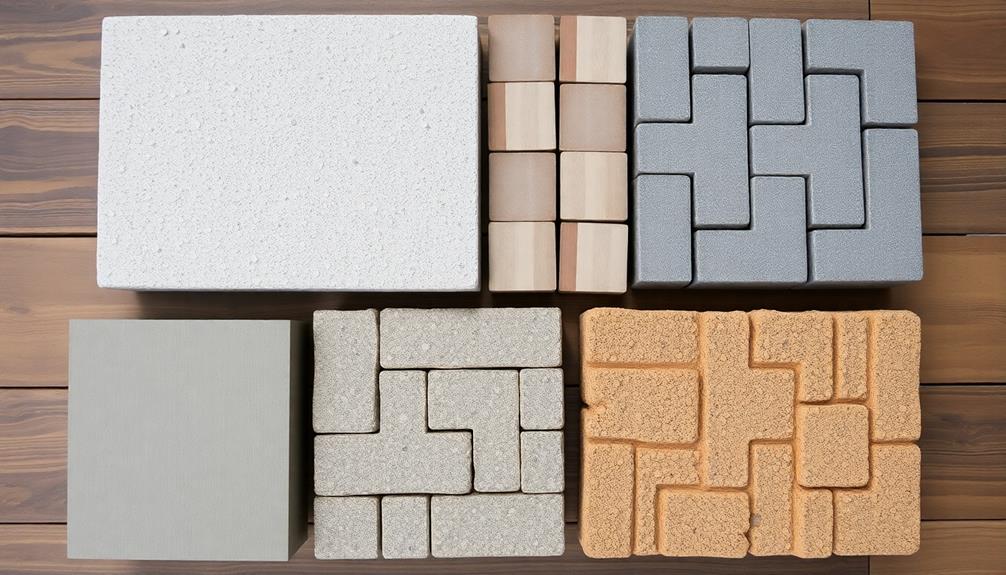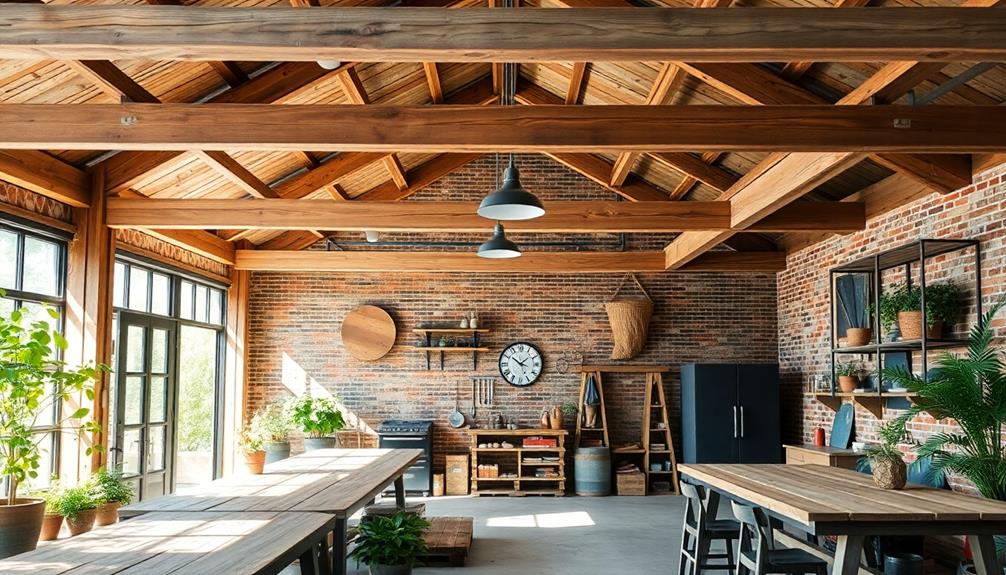You can save a significant amount on your upcoming project by opting for cost-effective building materials that combine quality and sustainability. Consider durable concrete options such as blocks or precast elements for added strength and fire resistance. Plywood is a versatile choice that provides stability for a variety of applications. Using reclaimed wood not only helps reduce expenses but also adds a unique touch to your project. Making eco-friendly selections like bamboo and recycled steel promotes environmentally responsible practices while enhancing the attractiveness of your project. Corrugated metal is able to withstand the elements with minimal maintenance requirements. By choosing these economical options, you can ensure both durability and style in your construction. Delve deeper into your options to uncover even more valuable insights.
Key Takeaways
- Explore cost-effective options like concrete, plywood, and reclaimed materials to significantly reduce material expenses while maintaining quality.
- Consider durable alternatives such as rammed earth, bamboo, and shipping containers for innovative and sustainable building solutions.
- Utilize corrugated metal and recycled steel for their low maintenance requirements and long lifespan, enhancing project affordability.
- Incorporate eco-friendly materials like Timbercrete and ecobricks to promote sustainability and attract eco-conscious clients.
- Leverage the unique aesthetic of reclaimed wood and other materials to enhance project character and appeal.
Concrete and Alternatives

When it comes to building materials, concrete and its alternatives stand out for their durability and versatility.
You'll find concrete essential for various applications, thanks to its strong composition of water, cement, sand, and gravel. Precast elements can speed up your construction process, saving you time and labor costs.
If you consider concrete blocks, they offer excellent structural integrity and fire resistance, making them a low-maintenance choice.
Alternatively, rammed earth provides an eco-friendly option with impressive thermal performance, ensuring energy efficiency.
These materials not only meet your construction needs but also provide longevity and resilience, allowing you to create lasting structures that withstand the test of time.
Choose wisely for your next project!
Versatile Plywood Applications

Building on the foundation of robust materials like concrete, plywood emerges as a versatile choice in construction projects. You can use it for various applications, making it an essential material in your toolkit.
For instance, plywood forms sturdy walls that provide stability for both interior and exterior spaces. It's also perfect for roofs, serving as a reliable substrate for roofing materials.
When it comes to flooring, plywood acts as an underlayment, enhancing the durability of different flooring types. Additionally, you can utilize plywood for structural purposes, such as beams and load-bearing elements.
Its resistance to warping further guarantees that your projects last longer, making it a smart investment for any construction endeavor.
Benefits of Reclaimed Materials

Reclaimed materials bring a wealth of benefits to your construction projects. By choosing reclaimed wood or recycled materials, you not only save money but also enhance the character of your builds.
Here are three key advantages:
- Cost Savings: Reclaimed materials are often more affordable than new options, helping you stick to your budget while achieving your design goals.
- Unique Aesthetic: Each piece of reclaimed wood tells a story, adding distinct charm and character to your space that new materials simply can't replicate.
- Sustainability: Using reclaimed materials reduces the demand for new resources, making your project more environmentally friendly and supporting responsible building practices.
Incorporating reclaimed materials into your next project can offer both economic and aesthetic benefits.
Eco-Friendly Building Options

Eco-friendly building options are gaining traction as more people recognize their importance. By choosing sustainable materials, you can reduce your environmental impact while saving money on your next project. Consider options like Timbercrete, which combines sawdust and concrete, or Ecobricks, made from plastic waste. These materials are not only affordable but also help minimize resource depletion.
| Material | Benefits | Cost-Effectiveness |
|---|---|---|
| Timbercrete | Durable, eco-friendly | Often cheaper than new materials |
| Ecobricks | Reduces waste, sustainable | Lowers project costs |
| Reclaimed Wood | Unique character, sustainable | Lower cost than new wood |
| Bamboo | Renewable, strong | Cost-effective option |
Incorporating these options supports sustainability and creates a healthier environment for everyone.
Innovative Alternative Materials

As you explore sustainable choices for your project, innovative alternative materials can offer exciting options that go beyond traditional selections.
These materials not only enhance your design but also promote environmental responsibility. Here are three innovative alternatives to evaluate:
- Bamboo: This fast-growing resource is lightweight, strong, and naturally insulating, making it an eco-friendly substitute for wood.
- Straw Bales: Biodegradable and highly insulating, straw bales provide a cost-effective way to build energy-efficient walls.
- Shipping Containers: Readily available and durable, shipping containers are versatile for various structures and can be easily modified for residential or commercial use.
Economic Advantages of Affordable Materials

When you're working on a project, choosing affordable materials can greatly impact your budget and overall feasibility. By opting for cost-effective options, you can considerably reduce material expenses, freeing up funds for other essential aspects of your project.
This approach not only enhances your project's viability but also opens doors to innovative design solutions that might otherwise be out of reach. Additionally, sustainable materials often attract eco-conscious clients, increasing your marketability.
You'll benefit from long-term savings as well, since many affordable materials require less maintenance and can lead to lower energy costs.
Ultimately, selecting budget-friendly materials allows you to create a successful project while maximizing your financial resources.
Advantages of Corrugated Metal

Utilizing corrugated metal in your construction project offers a range of advantages that can enhance both functionality and aesthetics.
This versatile material isn't only durable but also lightweight, making it easy to handle and install.
Here are three key benefits to evaluate:
- Weather Resistance: Corrugated metal withstands harsh weather conditions, protecting your structure from rain, wind, and snow.
- Cost-Efficiency: Its affordability and low maintenance requirements can greatly reduce your overall project costs.
- Modern Aesthetic: The sleek, industrial look of corrugated metal adds a contemporary touch to buildings, enhancing their visual appeal.
Cost-Effective Recycled Steel

Recycled steel stands out as a cost-effective choice for construction projects, offering both economic and environmental benefits. By repurposing existing materials, it reduces the need for new steel production, saving energy and minimizing waste.
You'll find that recycled steel is durable and strong, making it suitable for various structural applications, from framing to roofing. Plus, it's resistant to pests and fire, enhancing safety and longevity.
Choosing recycled steel can greatly lower your material costs without compromising quality. Additionally, its availability and versatility make it an attractive option for builders looking to innovate while staying budget-conscious.
Embrace recycled steel in your next project, and enjoy its benefits for both your wallet and the planet.
Unique Features of Reclaimed Wood

Reclaimed wood brings a unique charm that sets it apart from new lumber, making it a standout choice for your projects.
Not only does it offer an appealing aesthetic, but it also contributes to sustainability.
Here are some of its unique features:
- Character: Each piece has a story, showcasing rich textures and colors that add warmth to your space.
- Sustainability: Using reclaimed wood reduces the demand for new timber, helping preserve forests and lessen deforestation.
- Cost-effectiveness: Often more affordable than new wood, reclaimed options can save you money while enhancing your design.
Performance and Durability Insights

When choosing materials for your project, understanding their performance and durability is essential for long-term success.
Materials like concrete and concrete blocks offer excellent fire resistance and thermal mass, promoting energy efficiency. Rammed earth and cob also provide great thermal properties, ensuring comfortable indoor temperatures while being cost-effective.
For structural integrity, recycled steel and corrugated metal stand out due to their strength and low maintenance requirements. These materials resist pests and fire, contributing to their durability.
By selecting options that combine performance with resilience, you'll not only enhance the longevity of your project but also save on maintenance costs in the long run.
Prioritize materials that meet your project's needs while ensuring sustainability and affordability.
Frequently Asked Questions
What Are the Best Practices for Sourcing Affordable Building Materials?
When sourcing affordable building materials, you should research local suppliers, consider reclaimed materials, compare prices online, and explore eco-friendly options. Networking with contractors can also reveal hidden gems and discounts in your area.
How Does Climate Affect the Choice of Building Materials?
Choosing building materials is like selecting a wardrobe; climate dictates your options. In cold areas, you'll need insulating materials, while warmer climates demand heat-resistant choices. Always consider local weather patterns to enhance durability and comfort.
Are There Financing Options for Sustainable Building Materials?
You've got several financing options for sustainable building materials. Consider green loans, government grants, and tax incentives. These can help lower your upfront costs, making eco-friendly choices more accessible and budget-friendly for your projects.
How Can I Ensure Quality When Using Reclaimed Materials?
As you sift through reclaimed wood, the rich scent of history fills the air. Inspect for structural integrity, check for pests, and verify it's properly treated. You'll guarantee quality while embracing unique character in your project. The worn textures and weathered patina of each piece tell stories of past lives, adding a sense of timelessness to your creation. As with any material, pairing reclaimed wood with the natural charm of building with stone can enhance the aesthetic, blending warmth with solidity. Every step you take in selecting materials becomes a nod to craftsmanship, ensuring longevity while respecting history. Each beam, plank, and board you choose contributes to a narrative that transcends time, marrying craftsmanship with sustainability. Drawing from *interior design Indonesia insights*, one can see how blending reclaimed wood with locally sourced materials fosters a sense of place and cultural reverence. The fusion of old and new, traditional and modern, creates spaces that are not only visually stunning but also deeply meaningful, rooted in history and reflective of intentional design choices.
What Are the Local Regulations for Using Alternative Building Materials?
You'll need to check local regulations regarding alternative building materials. Research zoning laws, building codes, and permits. Consulting with local authorities or a knowledgeable contractor can help guarantee compliance and avoid potential issues during construction.
Conclusion
In construction, you truly get what you pay for, but that doesn't mean you have to overspend. By choosing affordable building materials like concrete, reclaimed wood, and innovative options, you can achieve your project goals without sacrificing quality or sustainability. Remember, a well-informed choice today can lead to lasting benefits tomorrow. So, embrace these options and build something remarkable that reflects your vision while keeping costs manageable and the environment in mind!









